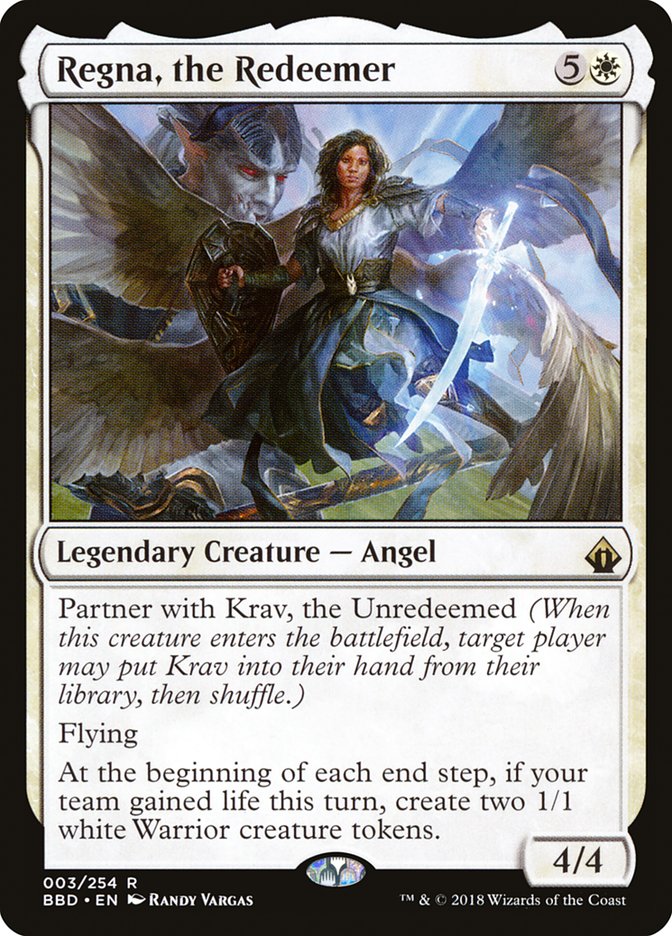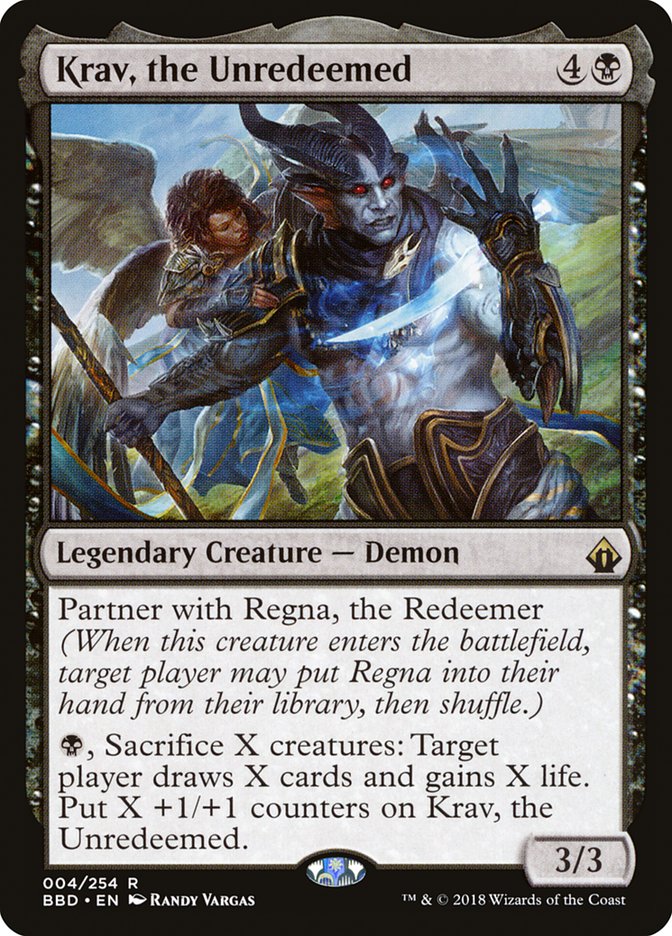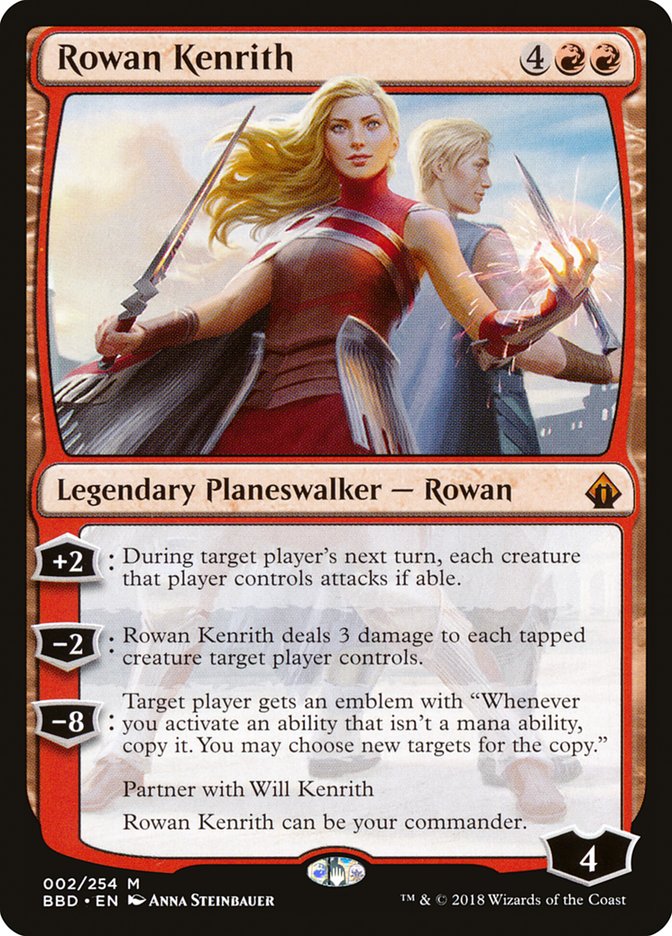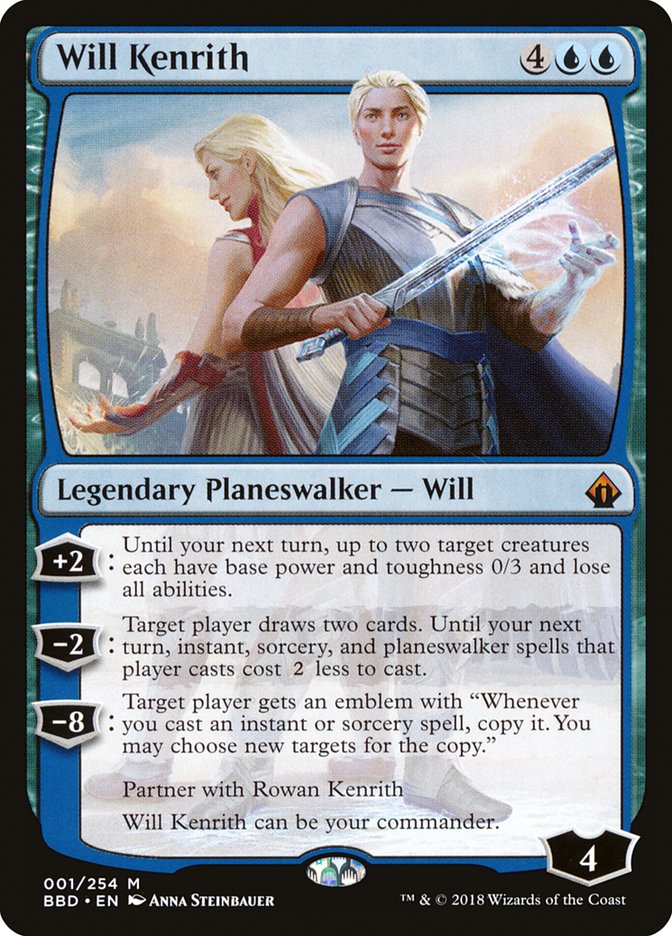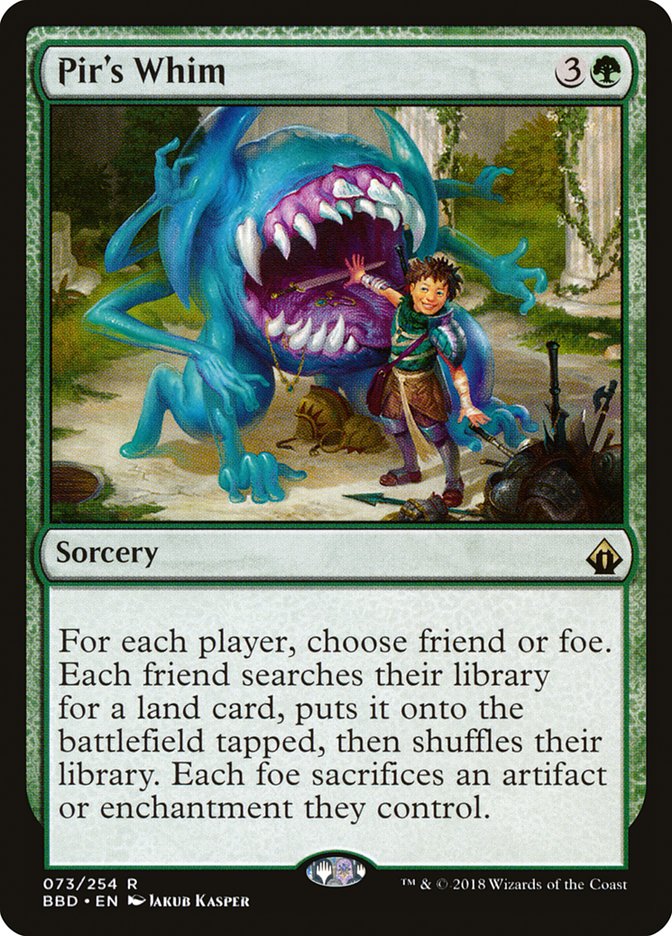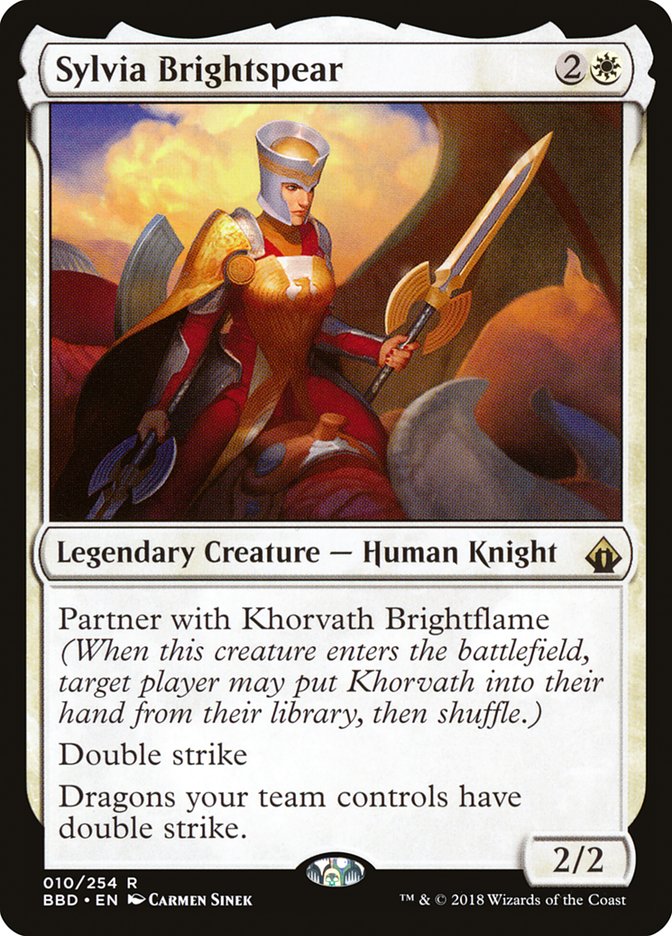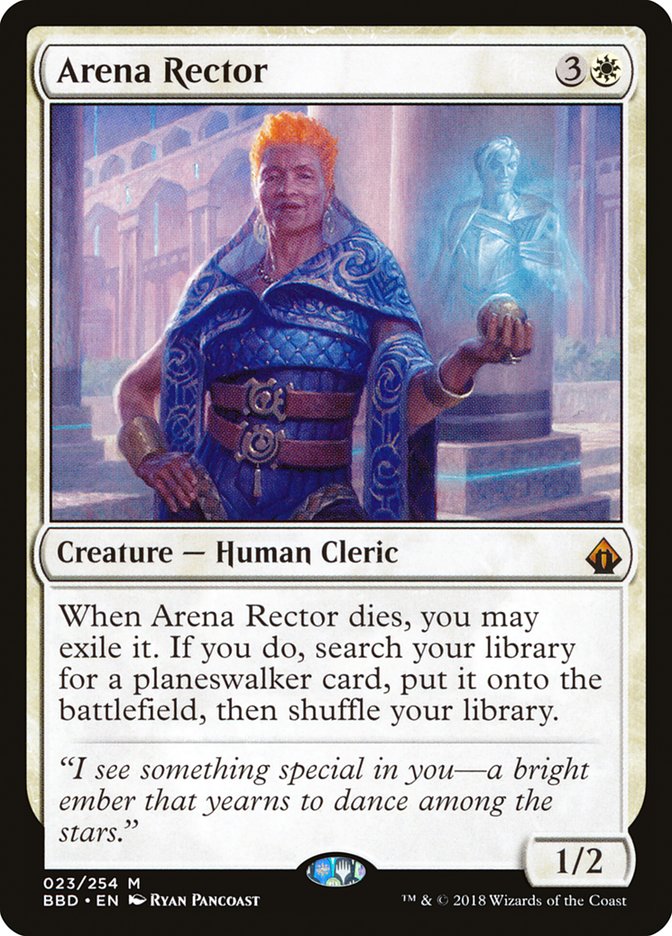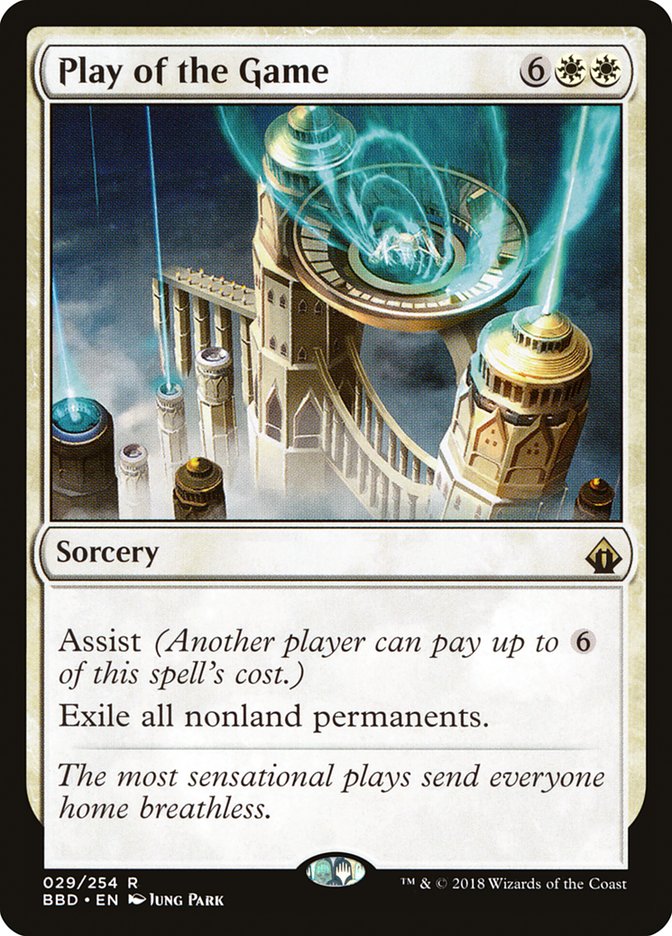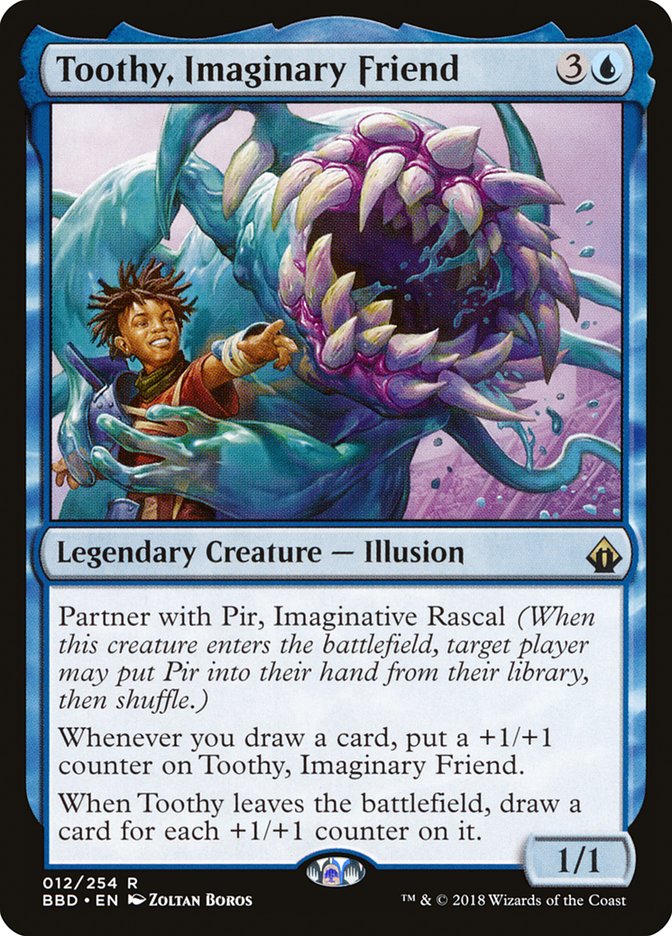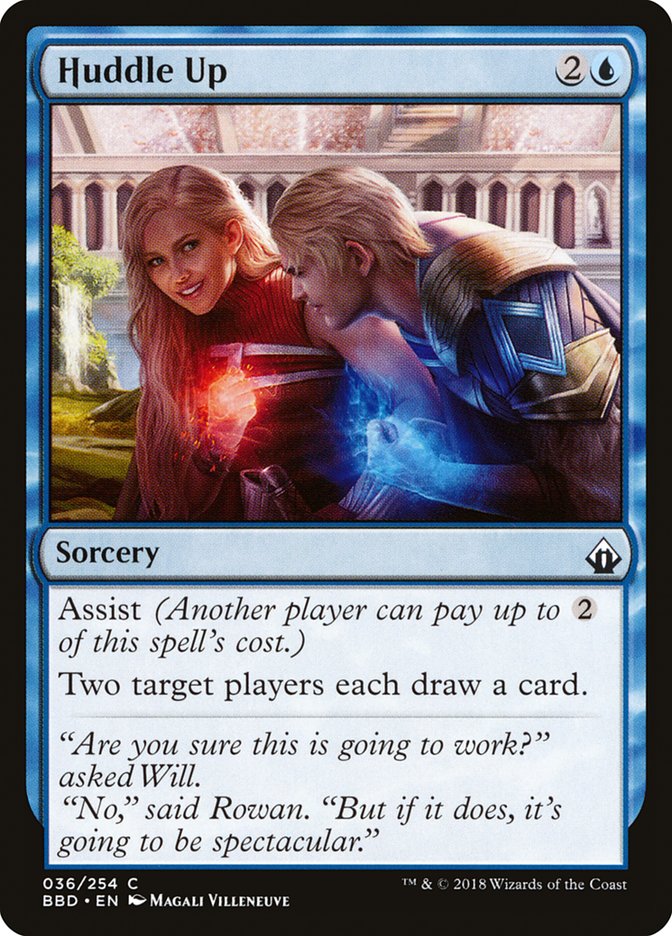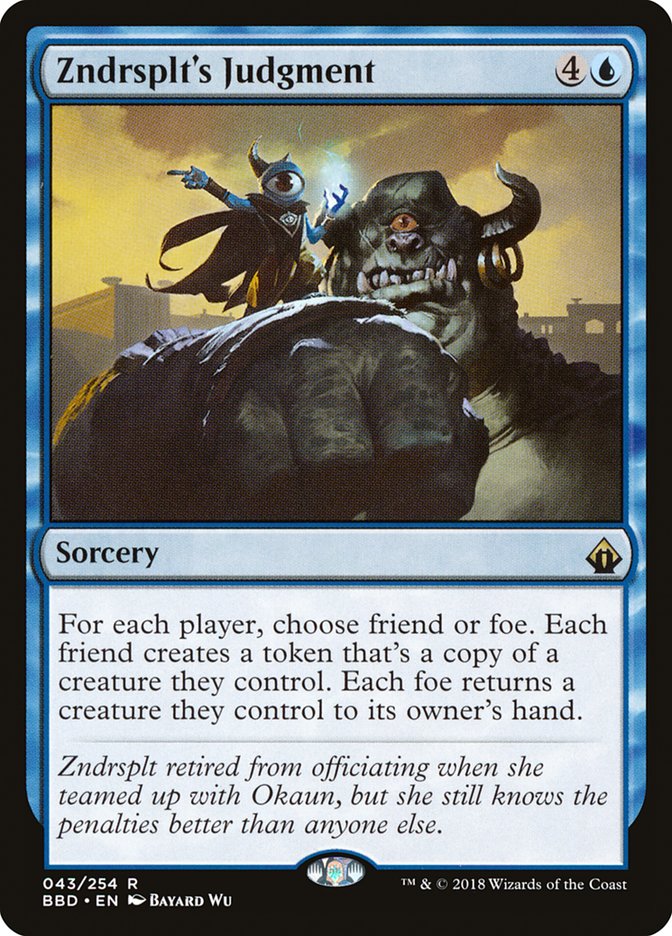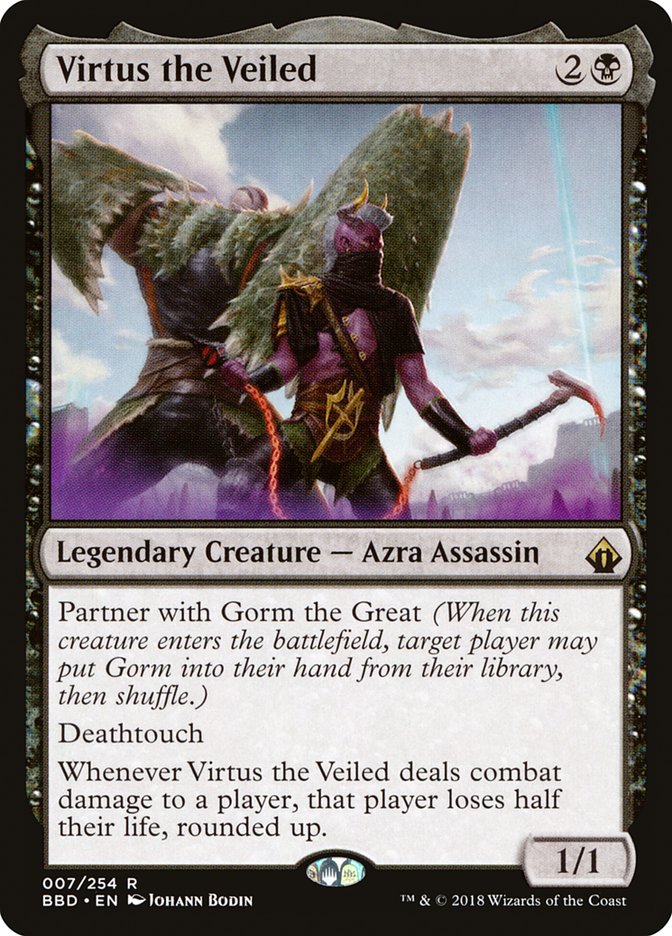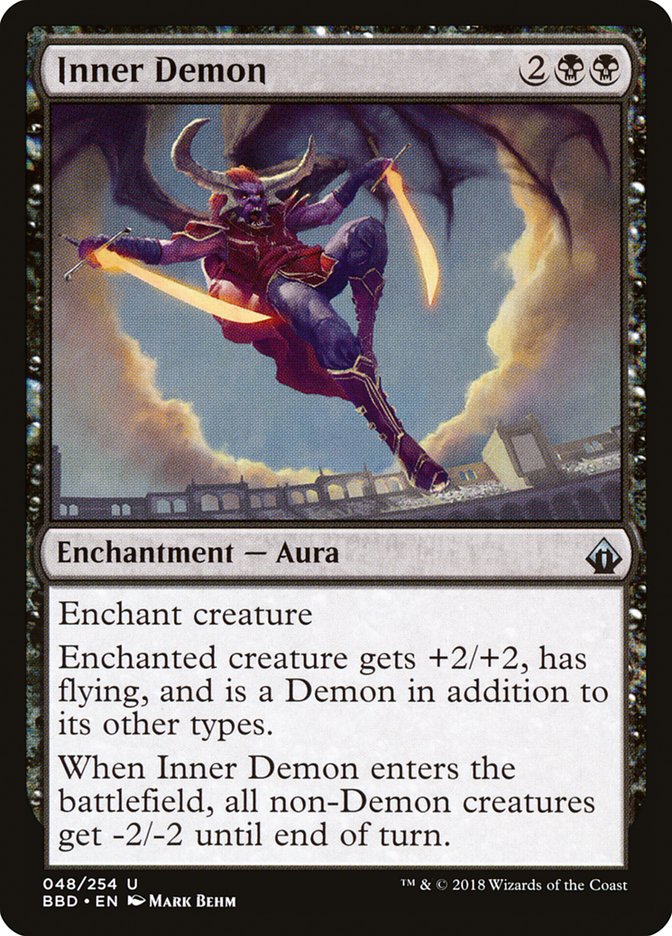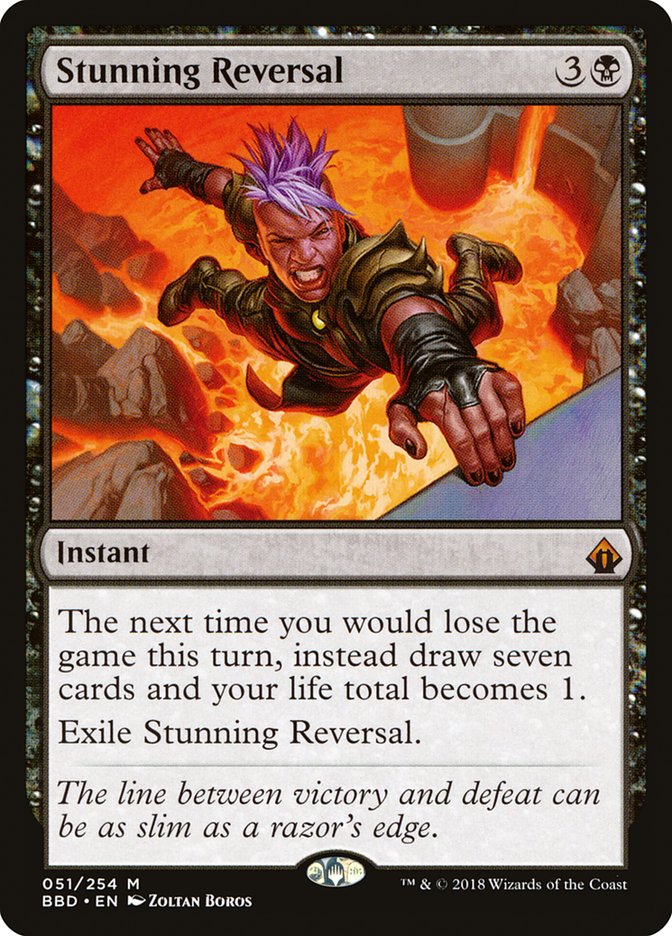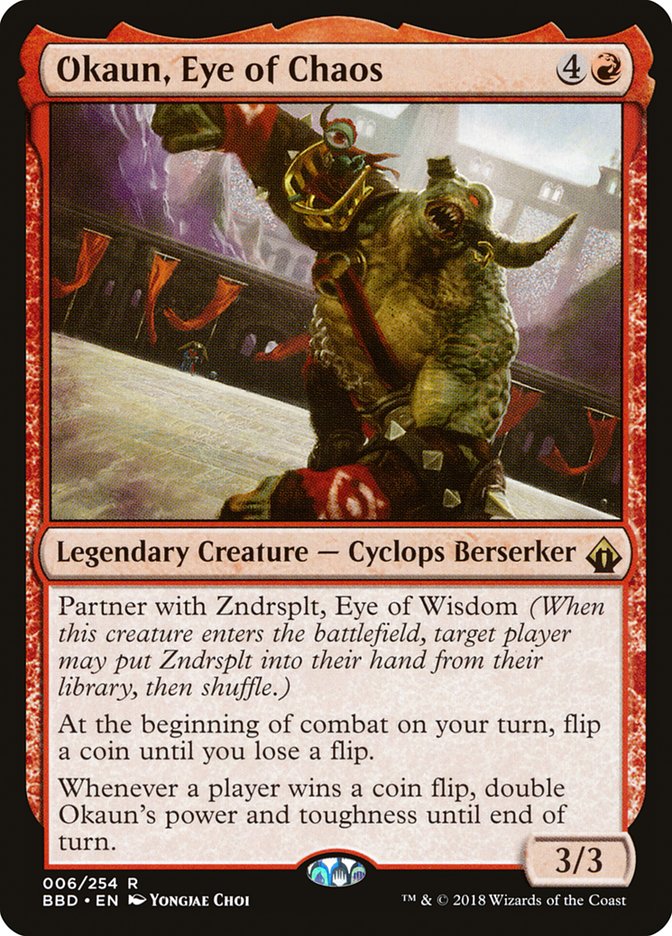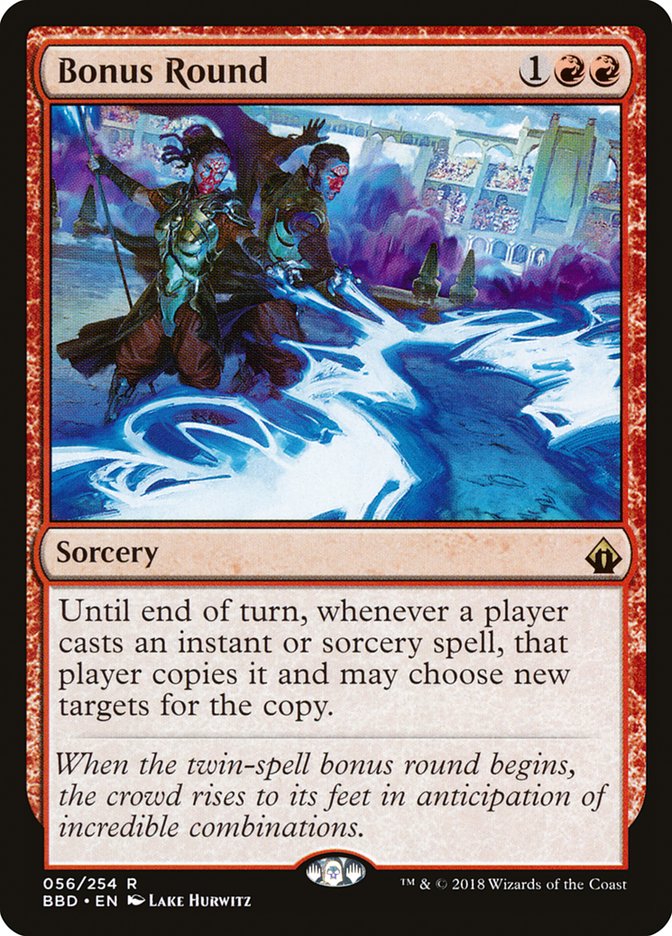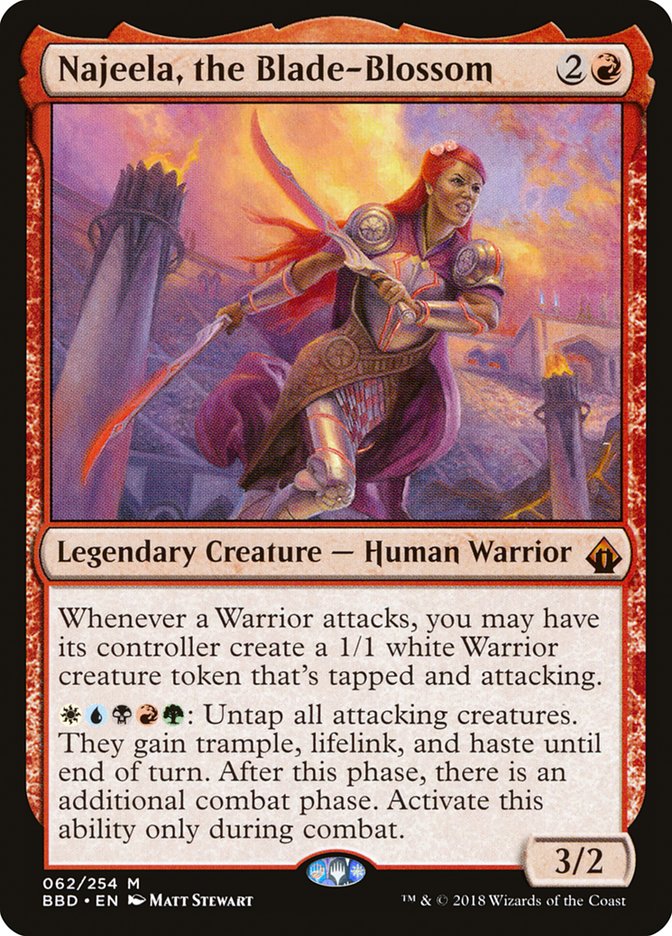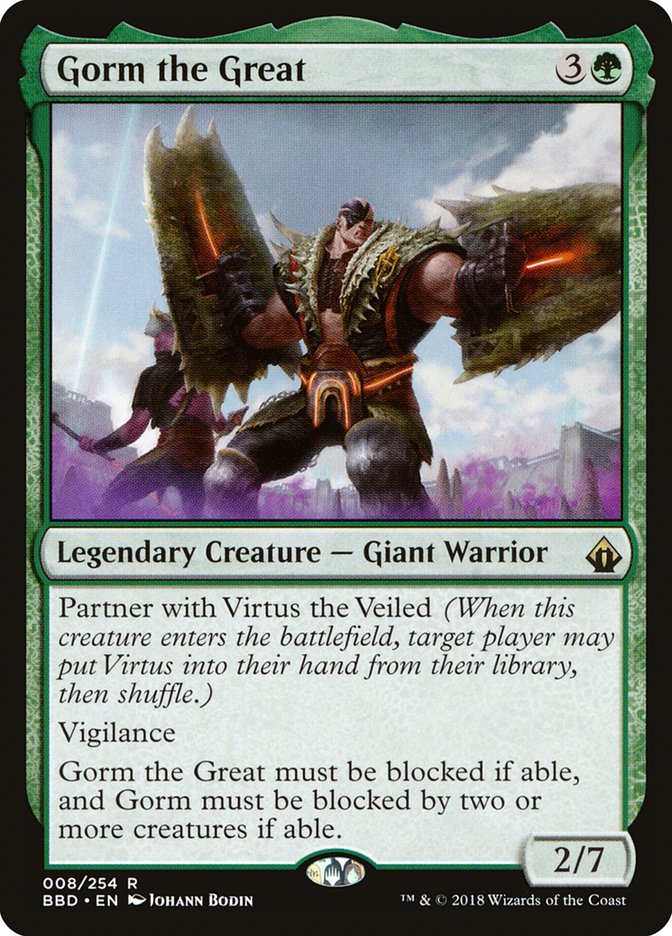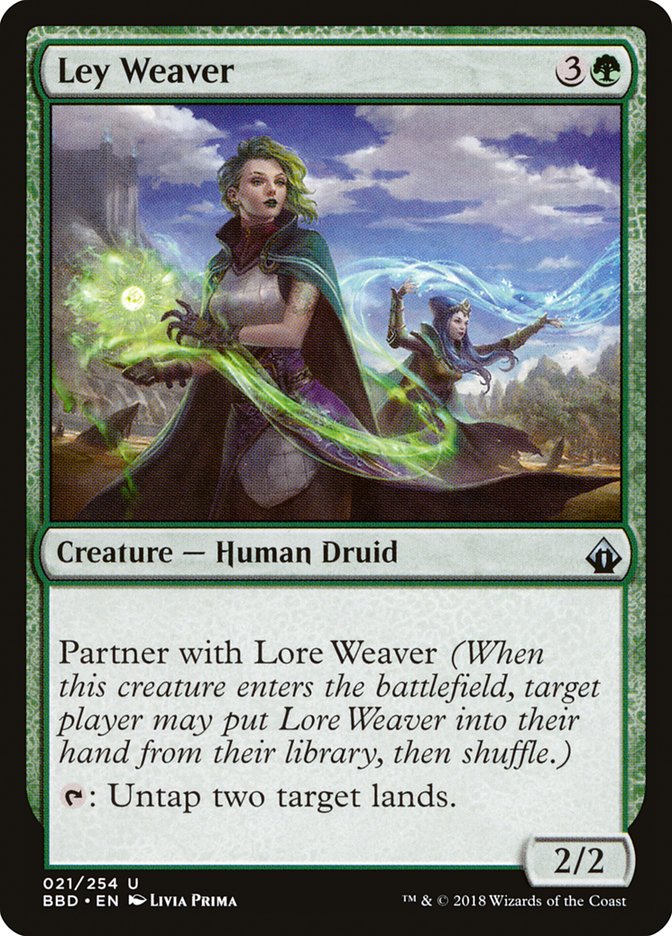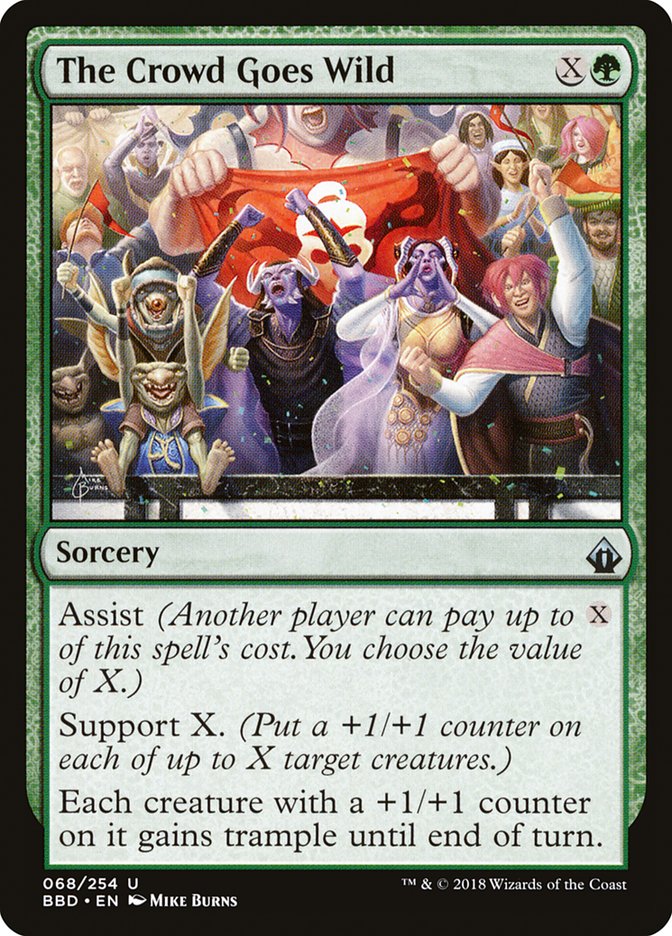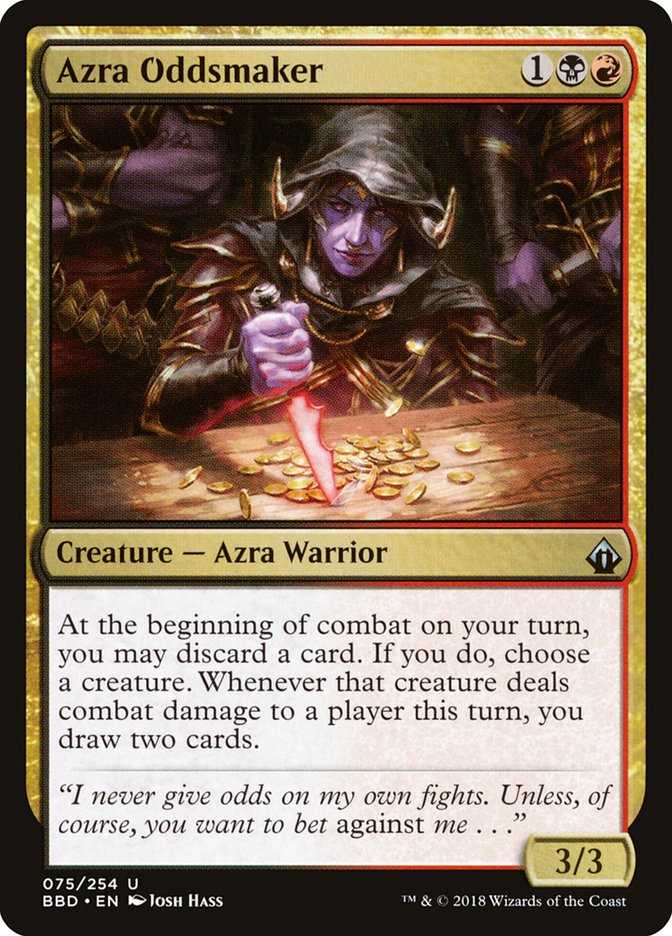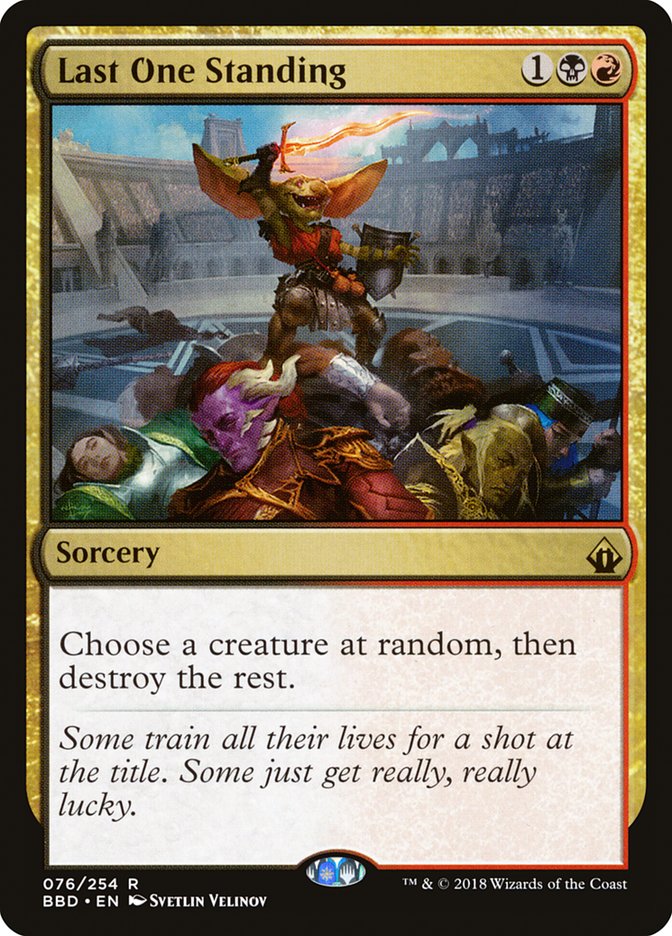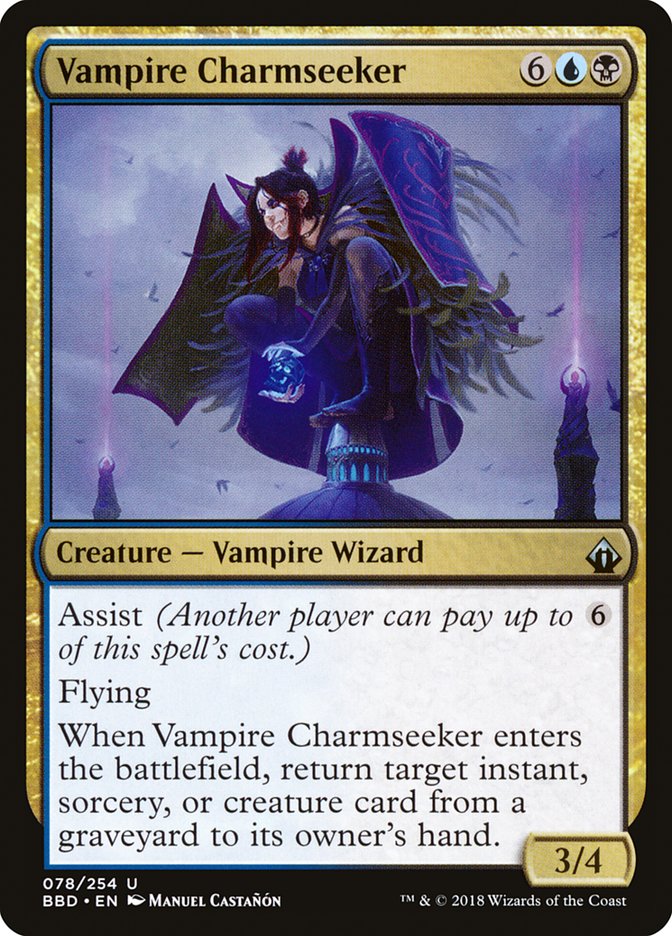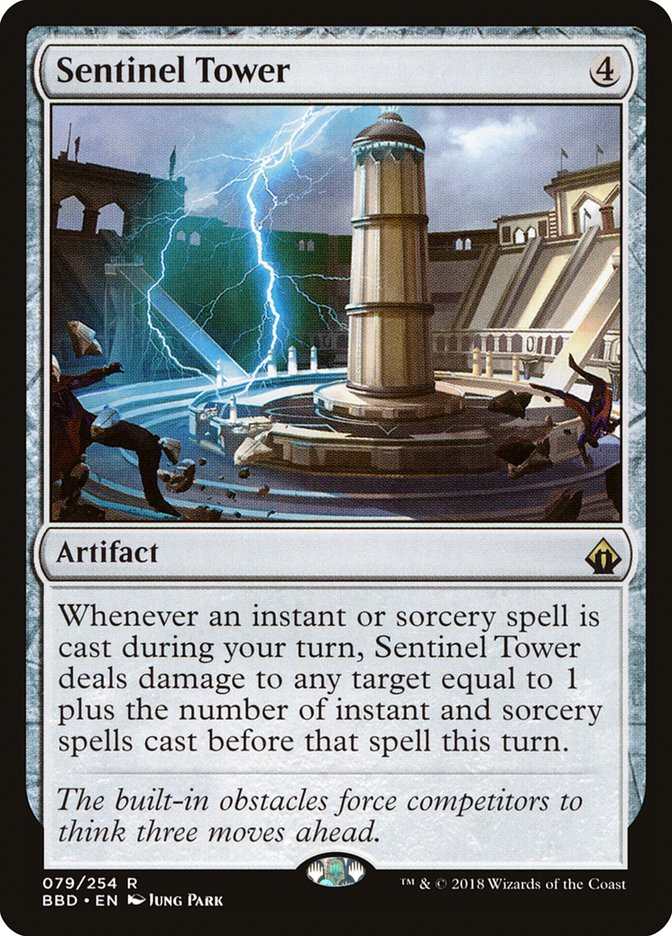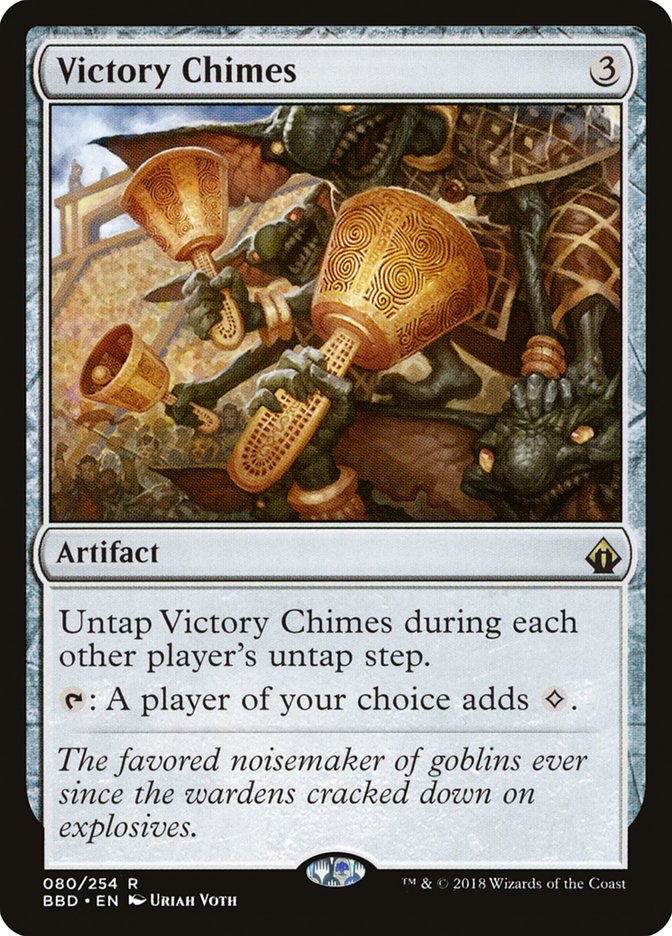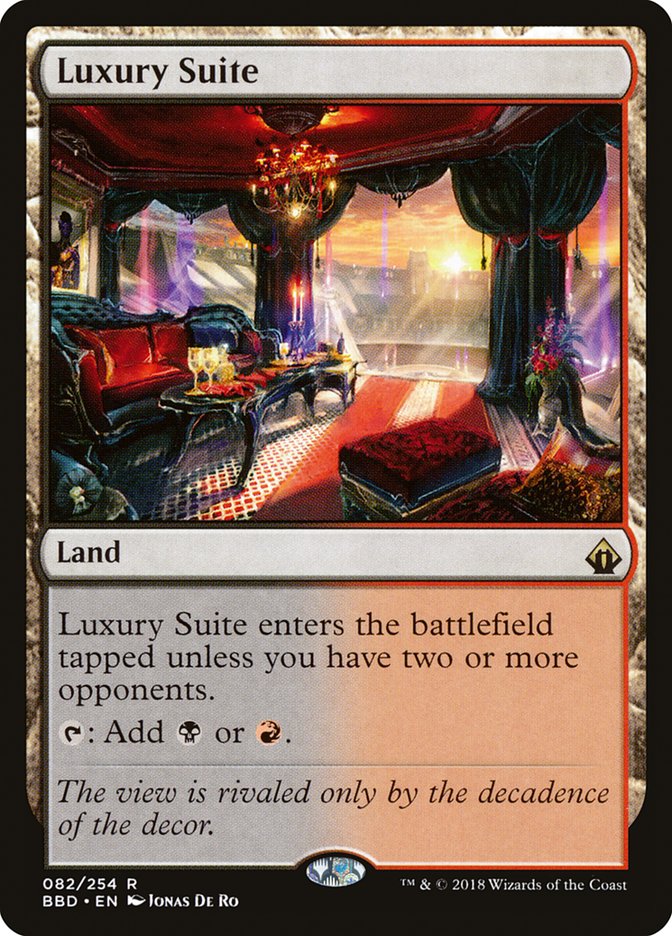Our friends in Magic: the Gathering R&D didn’t make Battlebond, Magic’s newest set (releasing June 8), specifically for Commander players, but there are some sweet things in it for us nonetheless. Designed as a multiplayer set targeted at the Two-Headed Giant (2HG) format, Battlebond and its new cards and new mechanics will have Commander players looking for things to remove from their decks so that they can squeeze in these tasty new treats.
Before we get to the cards, let’s first talk about the mechanics. There are two new keywords: Assist and Partner With. They’re both relatively easy to wrap our heads around. Assist lets other players help cast a spell.
For example, Bring Down is a sorcery for 3W with Assist 3. It destroys a target creature with power 4 or greater. If you can secure an agreement to pay the other 3 from another player (obviously, in 2HG, you’ll be pretty confident that a yes answer is coming), then you can cast it for just W.
You can use Assist as both a bargaining chip or relationship-building tool. The player to your left (assuming they’re not the one who has the threatening creature) is in the best position to help pay for it, since they’re about to untap next. You can get the other player to help you in exchange for a favor, like helping them pay for something later, or not blowing up one of their permanents. I can see something like, “If you pay the 3 for Bring Down, that’ll give me the mana to cast a creature, which I’ll use when Aura Shards triggers to blow up something other than your cool artifact.”
You can also use Assist for a bit of extortion. “I have Bring Down. I’ll pay the W, but someone else has to come up with the 3. If you don’t, fine. I’m playing white, which means you know I have Mirror Strike in my deck; they’re probably attacking one of you, not me.” Adding layers of strategic negotiation makes the mechanic both fun and compelling. Note that if someone agrees to pay, then when you cast the spell they don’t, you don’t have to cast it. They can’t dagger you and leave you hanging. You might still choose to, but never trust them again. That kind of move reveals their character; when someone shows you who they are, believe them. I don’t actually imagine this being too big of a problem, but you never know.
Partner With is just like Partner, only you don’t have a choice who the other commander is. If you’re using Regna, the Redeemer as a Partner commander, then you have to use Krav, the Unredeemed. It also means an additional thing. When one of the two enters the battlefield, you can search your library for the other and put it into your hand. There’s an issue here, though. If you’re partnering the two, you can’t search the command zone for it; you only search your library. If you want to take advantage of the triggered ability, you can’t get it from any other zone.
You have some flexibility, of course. If you want to play a spell like Oblation, you can choose to not put the card into the command zone, instead shuffling it into your library—then making it available to go get when the other enters the battlefield. This is a neat way of circumventing the commander tax. At first glimpse, I think I’m going to choose the Partner With legendary creatures as simply 2 of 99, just using the triggered ability for some cool value. That value might be extended if you play a card like Wheel of Sun and Moon, and the cards go into the library instead of the graveyard. There’s another wrinkle: there are nonlegendary creatures that have Partner With. Those creatures can’t be your commanders, they can simply summon each other to the fight.
There are two Planeswalkers that have Partner With which can also be your commander, Rowan Kenrith and Will Kenrith. If you’d like to play both of them as commanders, they’re just like other Partner With cards. Since someone is going to ask, this isn’t a prelude to allowing all planeswalkers as commanders. The R&D folks are exploring some cool space, but that’s all. If you’re really itching to play planeswalkers as commanders, Brawl is an excellent opportunity for you to do so.
Remember that if a potential commander has Partner With, you can choose to play it alone (just like Partner). There’s no requirement for you to play both as commanders. Obviously, you can’t make Rowan 1 of 99 if you’re playing Will as the commander, since she doesn’t fit the color identity. This is the pair that I’m most likely to play as Partner commanders, since it’s a new and interesting choice for a historically underrepresented pair, blue-red.
There’s one more mechanic in Battlebond, although it’s not a keyword, called friend or foe. When the spell resolves, for each player (to include yourself), you choose friend or foe. Friends get good things; foes either don’t or get something bad. In Two-Headed Giant, you’re pretty likely to have obvious choices and choose at least one friend. In normal multiplayer games, you might not—although I’d consider instituting a “soft” rule in my local group that you always have to choose at least one friend other than yourself. I wouldn’t suggest trying to make this an official ruling, or even criticize anyone who disagrees. It just feels like a cool stylistic choice. I’ll reserve judgment until we play with them for a bit.
Like with Assist, you can certainly use friend or foe politically. You can offer friendship in exchange for something or as a “get out of a beating” card (“If you don’t attack me for a turn, I’ll make you a friend on this card). You don’t have to use it politically at all, though. You can just lay the screws to all your opponents and keep the goodies for yourself (like with Party Jace Beleren). Remember that the choice of friend or foe comes on resolution—so once again, if someone promises you one thing and does another, just stop playing with them altogether. You’ll be happier in the long run.
I sincerely hope that Assist is a mechanic they continue to explore in future multiplayer sets. It seems like they’ve already committed to doing more with Partner, a notion which we support with some fervor.
Let’s move from talking about the mechanics to discussing a few of the cards. This won’t exactly be a set review, but I’ll look a some of the neat new cards (and maybe mention a saucy reprint or two) that I think you’ll likely see coming your way in the next few weeks.
White
Regna, the Redeemer: Partnering with Krav, the Unredeemed for an Angel/Demon pair, Regna makes some sense in any deck that gains life, which Angels tend to do. Using the two of them together, activating Krav will trigger Regna. That’s high synergy, and something that a black/white deck is likely to do lots of. I mentioned that I’d likely be playing most of the new cards without making them commanders; these two might be my first exception.
Sylvia Brightspear: Dragons having double strike is most of what we need to know about Sylvia Brightspear. And that her Partner is a Dragon (Angels/Demons; Knights/Dragons? Think we’re establishing a pattern).
Blaring Recruiter: One of the Partner With non-legendary creatures, it’s definitely an insert into your Warrior deck (Mardu, so that you can also play Boldwyr Intimidator).
Arena Rector: One of the most talked-about cards in the set so far, it’s simply Academy Rector for a planeswalker instead of an enchantment.
Brightling: A cheaper, white Morphling variant? I’m there.
Play of the Game: In what will no doubt end up as an extremely political card, Play of the Game is certainly worth it even if you don’t have help. If you can get the assistance, you can also use the mana that someone else spent to instead rebuild your own side. It’s not like the other players won’t see this coming; I suspect you won’t trick too many folks with that one. Still you can give them a difficult choice, and letting you have a six-drop is often better than allowing an absurd board state to continue.
Regna’s Sanction: A decent bargaining chip, don’t undervalue making someone a friend even if they only have one or two creatures; in fact, that’s probably worth it in the long run. Also don’t undervalue this card as a way of getting most potential blockers out of the way if you want to go wide with your now-larger creatures.
Best Reprints: Land Tax, Silverchase Fox, and Swords to Plowshares. Foily Land Tax for slightly less than kidney price.
Blue
Will Kenrith: It’s hard to pick which ability I like more. Using the +2 will get you to the emblem easier, since it will help defend the Planeswalker. I will put this into my You Did This to Yourself deck and see how often I can get that emblem.
Zndrsplt, Eye of Wisdom: Okay, what everyone wants to know is if it’s pronounced ZinderSPLIT or ZinderSPILT. Obviously, it’s going into your chaos/coin-flipping deck, which will have red so that you can play all those cards. I’d probably also let you play Goblin Bookie just for the laughs.
Toothy, Imaginary Friend: Except for the really terrible name (although it simply seems like Battlebond might be targeting a somewhat younger Magic demographic), this is a great card, even without being partnered with Pir, Imaginative Rascal. It’s an excellent Chasm Skulker variant, and with its partner gives you access to the two best colors in Commander.
Game Plan: You’re probably always going to find someone to help you pay for Game Plan, since at least one person will have a low grip count. Obviously, that’s not the case if you’re also playing Nekusar, the Mindrazer. It’s especially nice that it exiles itself so there are no shenanigans with it. Well-balanced card which will let you fill your hand for not a lot of mana.
Huddle Up: You’ll also always find someone willing to help you pay for this one; just make sure that the player you want to target actually has the two mana.
Spellseeker: I suppose this is one the combo decks want.
Zndrsplt’s Judgment: Lots of possibilities with this one. There will be times when you want to make yourself a foe so that you can bounce one of your own creatures. In 2HG, you and your teammate can both bounce a creature and then they can play a Wrath of God effect. All kinds of sauce.
Best Reprints: Mystic Confluence, Sower of Temptation, True-Name Nemesis (honorable mention to Phantom Warrior, since I own the original art).
Black
Krav, the Unredeemed: You know I love my sacrifice outlets; I’m jamming this right into my Halloween with Karador deck. Regna, the Redeemed is of the right color to come with it, but I doubt I will, since it doesn’t really synergize with the rest of the deck.
Virtus the Veiled: I’m not a huge fan of the mechanic, but it makes me wonder what an Azra is.
Archfiend of Despair: It’s Wound Reflection all over again (plus the can’t gain life clause). The uses for the card are obvious; I might encourage you to try to find some less obvious, less feels-bad ways to play it.
Inner Demon: Infest for everyone except you is a decent choice, especially if it saves one of your few non-Demons.
Stunning Reversal: Stunning indeed! Might be better if it had Split Second. Okay, okay, that’s too much to ask. We’re still losing this game, but we’re giving ourselves a fighting chance.
Virtus’s Maneuver: I might warn you about other players wanting stuff in their graveyard, but you’re playing black, so you’re just going to Puppeteer Clique it back anyway. A straightforward card that’s really strong at 2B.
Best Reprints: Morbid Curiosity, Nirkana Revenant.
Red
Rowan Kenrith: Wait, what? That emblem is insane. Here we go, Brian Stoutarm! You’ll obviously have to be prepared when you use the +2 ability, so make sure you have some Fogs in hand.
Okaun, Eye of Chaos: Might be easy to one-shot with commander damage after having a number of cards with coin flips on them. Otherwise, it’s kind of meh.
Khorvath Brightflame: Flying Knights is certainly a thing. The good news is that there aren’t too many with power 5 or greater—but you’ll need to worry about an army of them. Khorvath and Sylvia definitely make a dangerous team.
Bonus Round: Just be warned that it’s for all players, so you can’t really get around counterspells in the bonus round.
Khorvath’s Fury: Everyone else is probably a foe here, unless you’re trying to keep someone alive so that they can help you stay alive, too.
Najeela, the Blade-Blossom: I’m looking forward to seeing all the different flavors of five-color Warrior decks that Najeela spawns. If you feel like it, you are welcome to give other players Warriors and extra combat steps. This is kind of a cool commander if your group likes the Star format, a five-player variant in which the two people sitting next to you are allies and the other two are enemies; you win when your enemies are eliminated. Najeela’s relatively low cost means that you can run her out there early and start beating down, as well as creating Warriors since she’s one herself.
Stolen Strategy: If for no other reason than to exile stuff from everyone, this is worth it. Being able to cast a cool spell is a sweet bonus.
Best Reprints: Boldwyr Intimidator, Magmatic Force, War’s Toll.
Green
Gorm the Great: Gorm might have to put down those shields to pick up the Bow of Nylea, but after that, it’s bad for the defenders.
Pir, Imaginative Rascal: A fair version of Hardened Scales on a stick. Pir will beg you endlessly to play Vigor with it.
Ley Weaver: Untapping one land is good enough to consider playing a creature; untapping two gets into the realm of wild in the format, when you can untap lands like Nykthos, Shrine to Nyx or Gaea’s Cradle. You’ll need it if you pair it with Lore Weaver, since it costs 5UU to draw those two cards.
Bramble Sovereign: Holy Riku of Two Reflections, Batman! And you can even give things to friends. There has to be a way to use the legend rule to make things awkward for somebody.
The Crowd Goes Wild: In your +1/+1 counter deck, you don’t even need other players’ help to make this useful. Giving the team trample can win games all on its own.
Generous Patron: A perfect companion to Hapatra, Vizier of Poisons and its best friend, Archfiend of Ifnir, the worst thing about Generous Patron might be that you’ll have to worry about decking yourself.
Grothama, All-Devouring: You’ll have to do some gymnastics to make Grothama useful to you. I know this is the case for many cards, but it becomes pretty good with Vigor on the battlefield. Otherwise, other players are going to draw more cards off of it than you are.
Jungle Wayfinder: Will find its way into group hug decks.
Pir’s Whim: I suppose it’s a whimsical card, because the friend and foe aspects don’t seem to have anything to do with each other. This is another one that you’ll have to struggle to find reasons to choose other players as friends, since there are so many great artifacts and enchantments running around the format.
Best Reprints: Doubling Season is the most talked-about card of the set, I think. It would be unwise to overlook some of the other amazeballs reprints, such as Greater Good, Seedborn Muse, Vigor, and Skyshroud Claim.
Multicolored
Archon of Valor’s Reach: It’s good enough to play without the triggered ability. Sure, it affects you, but you’re playing white/green, so you might be unlikely to play lots of instants. Or you might want to shut down sorceries so that no one can Wrath away your awesome Archon. Lots of choices here, and they’re all good for you.
Azra Oddsmaker: The odds seems pretty unfairly balanced in your favor here. And I still want to know what an Azra is.
Last One Standing: A pretty cheap board wipe, although you never know what you’re going to get out of it.
Vampire Charmseeker: I’m not sure anyone will ever pay full price for this. If other folks aren’t helping you (which you can perhaps get by promising to return something to their hand), you’ll probably be bringing it onto the battlefield through some kind of reanimation, like Zombify. And then blinking it over and over.
Best Reprints: Evil Twin, Savage Ventmaw.
Artifact and Land
Sentinel Tower: Seems kind of crazy in a deck led by Mizzix of the Igmagnus.
Victory Chimes: Seems like just what the doctor ordered for Blinky the Eldrazi (Displacer).
Bountiful Promenade, Luxury Suite, Morphic Pool, Sea of Clouds, Spire Garden: I like the move toward helping you fix mana without being too broken. Occasionally you’re going to get blown out late in the game when it’s just you and one other player and all you need is a land that enters the battlefield untapped, but you’re going to get good usage out of the lands way more often (although you’ll probably remember the blowouts).
Best Reprints: Genesis Chamber, Mind’s Eye.
***
Although Battlebond isn’t a Commander-specific product, its contents indicate a growing trend toward making cards for players of competitive and casual formats alike. This can only be good for Magic as it grows our already-large fan base. It’s good for Commander because we know that more than once a year, we’re going to get just the kind of cards we want to get our hands on. In addition to some most excellent (while not being overpowered) new cards, the reprints will get some desirable foils into the hands of folks who are on a more limited budget. All in all, Battlebond is a win for Magic players of every type.
This week’s Deck Without Comment is the Rith Do-Over.
Creatures (38)
- 1 Wall of Blossoms
- 1 Soul Warden
- 1 Krosan Tusker
- 1 Tornado Elemental
- 1 Eternal Witness
- 1 Auriok Champion
- 1 Duplicant
- 1 Fierce Empath
- 1 Auramancer
- 1 Brooding Saurian
- 1 Juniper Order Ranger
- 1 Deadwood Treefolk
- 1 Stonecloaker
- 1 Galepowder Mage
- 1 Masked Admirers
- 1 Reveillark
- 1 Farhaven Elf
- 1 Paleoloth
- 1 Dauntless Escort
- 1 Devout Lightcaster
- 1 Kor Cartographer
- 1 Terastodon
- 1 Inferno Titan
- 1 Sun Titan
- 1 Sunblast Angel
- 1 Invader Parasite
- 1 Stonehorn Dignitary
- 1 Fiend Hunter
- 1 Restoration Angel
- 1 Champion of Lambholt
- 1 Trostani, Selesnya's Voice
- 1 Luminate Primordial
- 1 Angel of Finality
- 1 Reclamation Sage
- 1 Oreskos Explorer
- 1 Eldrazi Displacer
- 1 Thalia, Heretic Cathar
- 1 Selfless Spirit
Planeswalkers (2)
Lands (37)
Spells (22)
- 1 Goblin Bombardment
- 1 Kodama's Reach
- 1 Mirari's Wake
- 1 Astral Slide
- 1 Greater Good
- 1 Parallax Wave
- 1 Aura Shards
- 1 Congregation at Dawn
- 1 Ghostway
- 1 Cream of the Crop
- 1 Wheel of Sun and Moon
- 1 Minion Reflector
- 1 Lurking Predators
- 1 Explore
- 1 Warstorm Surge
- 1 Sudden Disappearance
- 1 Conjurer's Closet
- 1 Rootborn Defenses
- 1 Strionic Resonator
- 1 Elemental Bond
- 1 Arachnogenesis
- 1 Selvala's Stampede

Check out our comprehensive Deck List Database for lists of all my decks:
SIGNATURE DECKS
Purple Hippos and Maro Sorcerers; Kresh Into the Red Zone; Halloween with Karador; Dreaming of Intet; You Did This to Yourself.
THE CHROMATIC PROJECT
Mono-Color
Heliod, God of Enchantments; Thassa, God of Merfolk; Erebos and the Halls Of The Dead; Forge of Purphoros; Nylea of the Woodland Realm; Karn Evil No. 9.
Guilds
Lavinia Blinks; Obzedat, Ghost Killer; Aurelia Goes to War; Trostani and Her Angels; Lazav, Shapeshifting Mastermind; Zegana and a Dice Bag; Rakdos Reimagined; Glissa, Glissa; Ruric Thar and His Beastly Fight Club; Gisa and Geralf Together Forever.
Shards and Wedges
Adun’s Toolbox; Angry, Angry Dinos; Animar’s Swarm; Borrowing Stuff at Cutlass Point; Ikra and Kydele; Karrthus, Who Rains Fire From The Sky; Demons of Kaalia; Merieke’s Esper Dragons; Nath of the Value Leaf; Rith’s Tokens; The Mill-Meoplasm; The Altar of Thraximundar; The Threat of Yasova; Zombies of Tresserhorn.
Four Color
Yidris: Money for Nothing, Cards for Free; Saskia Unyielding; Breya Reshaped.
Five-Color
Partners
Tana and Kydele; Kynaios and Tiro; Ikra and Kydele.
THE DO-OVER PROJECT
Adun Oakenshield Do-Over; Animar Do-Over; Glissa Do-Over; Karador Do-Over; Karador Version 3; Karrthus Do-Over; Kresh Do-Over; Steam-Powered Merieke Do-Over; Lord of Tresserhorn Do-Over; Mimeoplasm Do-Over; Phelddagrif Do-Over; Rith Do-Over; Ruhan Do-Over.
If you’d like to follow the adventures of my Monday Night RPG group (in a campaign that’s been alive since 1987) which is just beginning the saga The Lost Cities of Nevinor, ask for an invitation to the Facebook group “Sheldon Menery’s Monday Night Gamers.”



